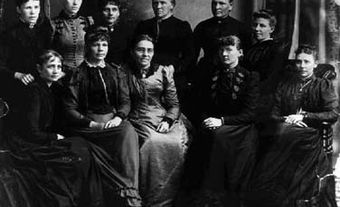Women and Education
Although women have always been well represented in schools as students and teachers, it is possible, by examining women's participation in schooling, to understand how that participation has both reflected and produced the unequal position of women in society. Prior to 1850, middle-class families tended to hire governesses and tutors to educate their children at home. By 1871, with the establishment of the free provincial public schools, the number of girls enrolled in Ontario schools approximated that of boys. More advanced education for female students was available only at private colleges, which provided special instruction in the personal, social and domestic proprieties. The curriculum was designed to train women in "the arts and graces of life" and to prepare them to become schoolteachers.
History
Teaching has always provided employment opportunities for women (see Teaching Profession). In the early 19th century, Canadian women taught children in private domestic settings, in so-called "dame" schools. Some pioneers ran their own schools; for example, Anne Langton (1804-93) ran a small informal school with her brother at Fenelon Falls. By midcentury, women began to be employed in public schools, and by 1900 elementary school teaching was done almost entirely by women. In 1872 the BC superintendent of education declared that a woman's mission was "predominantly that of an educator," specifically of infants and young children. The change occurred largely because women could be hired at lower wages than men at a time when the cost of an expanding school system weighed heavily on taxpayers. The change both caused and reflected an increasing acceptance of the participation of middle-class women in work outside the home and an ideology that emphasized women's special abilities to nurture and educate children.
While teaching provided new employment opportunities for many women (many prominent women suffragists entered the work force as teachers), it also reaffirmed the secondary position of women. Women teachers, paid less than men, were kept in the lower ranks and were supervised by male administrators. They were mainly young women, who left or were let go when they married and who rarely gained seniority or administrative responsibility.
Women Teachers Today
Women teachers today have generally won equal salaries with men and can no longer be laid off simply because they marry or have children. Women comprise about half of all teachers in the public schools, with many more in the lower grades than in the higher grades. While more than 95% of those teaching in preschools and kindergartens are women, more than 90% of full professors at universities are men. Women comprise more than half the teachers in the elementary grades and less than half in the secondary grades.
Many (over 32) major university reports were commissioned in the 1970s and early 1980s to investigate problems facing women. According to a 1984 report from the Commission on Canadian Studies, they had virtually no effect and discrimination against women in Canadian universities remained a "national disgrace." Women university teachers hold lower academic ranks and receive lower pay at every academic rank and in almost every age group. Employment equity legislation was introduced by the federal government in 1986 and provided a base for addressing these problems in the 1990s. Universities hired women's advisors and employment equity co-ordinators but their positions are again under threat as university funding declines and a movement against "political correctness" gains steam.
Girls and boys enjoy formally equal schooling. Canada's public-school system has always been overwhelmingly coeducational, but for reasons of convenience and cost, rather than a belief in the similar needs of male and female students. Girls have tended to stay in school longer than boys and to do better academically. It was only in 1950 that the number of males in school in the 15- to 19-year-old age group began to surpass that of females. The number of Canadian women who have graduated from high school still surpasses the number of men. In community colleges, women receive more than half of the diplomas granted. In universities, on the other hand, women comprised only 16% of undergraduate enrolment in 1920, almost 20% from 1930 to 1960, 35% by 1970, 50% by 1986 and over 50% in the 1990s. Women are 60% of part-time students at university and part-time students are increasing as a percentage of all students. Women students are making their largest gains at the university level.
Circumscribed Opportunities
Despite the evidence of women's achievements in school, the opportunities offered women in the educational system have been circumscribed by the view that women belong in the home and in traditionally female jobs. Analyses of textbooks, teaching materials, films and readers used in schools (see Curriculum Development) have consistently revealed that women are underrepresented and are portrayed in traditional ways. While publishers and ministries of education began, in the 1980s, to screen new materials for evidence of bias, old materials are still being used and the bases of the screening are debated. Women's-studies courses and materials have been developed to provide a balanced representation of women in the curriculum, but while most universities now offer women's studies as an option, materials conveying the experience of women are less often available at high-school or elementary-school levels.
Studies of teachers' attitudes toward sex roles and their interactions with students have also revealed that male and female students are treated differently. Male students receive both more praise and more criticism. Teachers reward traditionally "masculine" behaviour in boys and "feminine" behaviour in girls.
Male and female students often study different courses, particularly in the higher grades. In a system of academic electives, girls are more likely to drop out of mathematics, physics and chemistry than boys, and they are more likely to avoid industrial arts altogether. A 1984 report from the Science Council of Canada noted the low participation of girls in physical science courses and recommended changes in curriculum, teaching methods and Career Counselling to ensure greater involvement of girls in science and technology education. Girls comprise the majority of students in home economics, business education and languages.
At the community-college level women comprise more than 90% of the student body in nursing, rehabilitative medicine and secretarial science; more than 80% in library and Social Work; and more than 50% in education and the fine and applied arts. In universities, they are underrepresented in engineering, forestry, dentistry, architecture, computing science, law, business, science and medicine. These patterns are changing at the university level, where increasing numbers of women are enrolling in professional faculties dominated by men; but women remain a distinct minority in engineering.
These patterns of differential enrolment contribute directly to the maintenance of a sexually segregated work world. Moreover, women with the same educational credentials as men get paid less when they go to work. Guidance and career counsellors have also been criticized for their tendency to encourage girls to enter traditional fields. Feminist counsellors urge that more attention be paid to the fact that female students must plan for many years of work outside the home, must learn assertiveness and must examine the issue of sex-role stereotyping. The discussion and changes in schools generated by a renewed attention to women's place confronts parents, teachers and administrators with new dilemmas.
The notion that the school should reflect the community's standards sometimes conflicts with the notion that schools must provide equal opportunities for all students. A heterogeneous Canadian public does not uniformly accept the idea that women should be treated in the same way as men. Schools may promote equality by recognizing difference as well as denying any difference exists. Girls-only science classes as well as coeducational physical education remain contentious issues in the 1990s as communities try to decide what equal opportunities for girls and boys might be.

 Share on Facebook
Share on Facebook Share on X
Share on X Share by Email
Share by Email Share on Google Classroom
Share on Google Classroom


